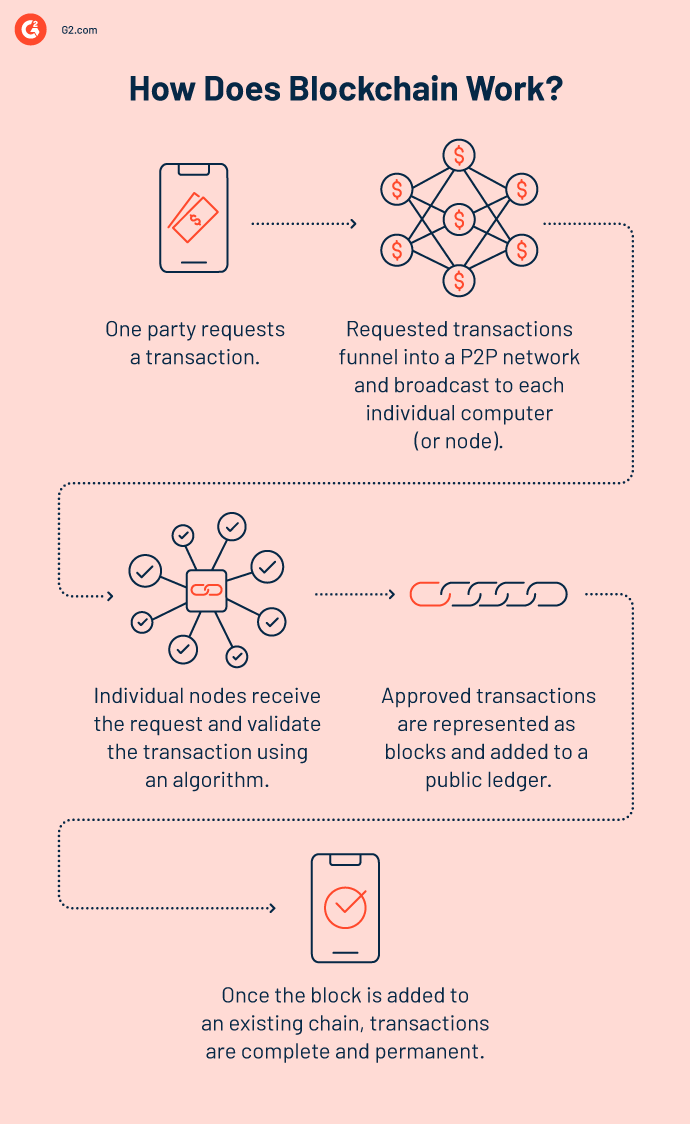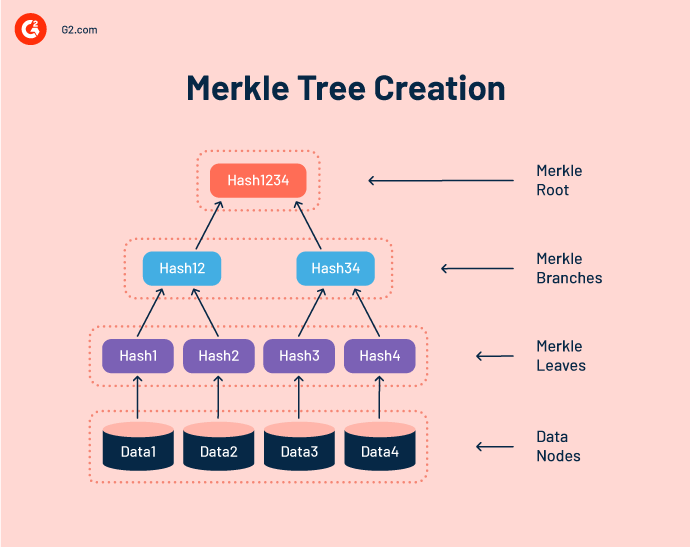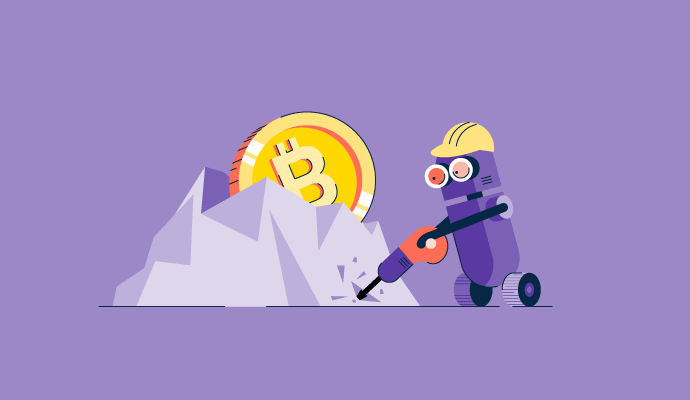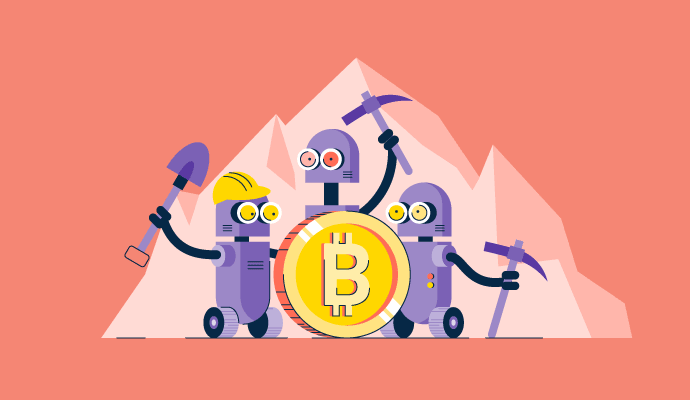Transaction legitimacy ensures a financial system’s integrity.That’s why banks and other lending institutions carefully investigate fraudulent activities. But what happens when peer-to-peer cryptocurrency transactions go through the same? No one safeguards your interest, and there isn’t a bank to protect funds.
Enter cryptocurrency and bitcoin mining.

Bitcoin mining is the process of creating and adding new bitcoins to the decentralized Bitcoin blockchain ledger after validating and confirming Bitcoin transactions. Bitcoin miners rely on sophisticated hardware to solve complex cryptographic hash equations to find the next Bitcoin block. Miners who find the block first receive Bitcoin rewards, hence the name Bitcoin mining.
Cryptocurrency mining software enables miners to add transactions to a distributed ledger after validating them on a blockchain network. A blockchain contains time-stamped records of all previous and subsequent transactions. Miners use nodes or mining machines or rigs to validate these transactions and receive mining rewards for their computational efforts.
What is crypto mining?
Cryptocurrency mining, or crypto mining, is a transactional process that creates new cryptocurrencies. It also validates and records crypto transaction data on a blockchain. Miners receive mining rewards such as transaction fees and newly created cryptocurrencies because of mining crypto with intensive computational resources and other cryptographic means.
The crypto coin creation and transaction validation process resembles the gold extraction and circulation process, hence the name 'mining.'
Think of cryptocurrencies as append-only public ledgers. People add pages or blocks to a ledger. The method of adding the next block is mining.
How does crypto mining work?
Crypto mining revolves around miners verifying transaction legitimacy and earning cryptocurrency as a reward. Understanding how blockchain works is crucial to learning the technologies and processes behind cryptocurrency mining.
Cryptocurrency and blockchain
Take any traditional cryptocurrency and you’ll see that it uses a decentralized ledger, aka blockchain. The chained data blocks in a blockchain contain key data and cryptographic hashes. These blocks represent data transactions that miners add to the end of a ledger.

Crypto transactions first go to a memory pool, or mempool, that stores unconfirmed transaction data. A mining node collects these transactions and combines them into a temporary candidate block.
Now, a miner verifies these candidate blocks to find valid transactions and organize them into blocks. In short, transactions become a part of the blockchain after validation.
On a more technical level, cryptocurrency mining technology uses a computer’s processing power to facilitate the entire process. The only way to add a block to the chain is to identify a cryptographic hash or function that aligns with the newest block.
The hash comes in a 64-digit hexadecimal number within an alphanumeric string. So, miners don’t perform any super-complex mathematical equations. They run equations to guess this sequence rapidly.
The only feasible way to arrive at a hash matching the correct criteria is to simply calculate as many hashes as possible and wait until you get a match. Miners can form a new block once they find the right hash.
Crypto mining rig components
A crypto mining rig is a customized personal computer with high-performance GPUs. It consists of the following items:
- Motherboard: Ensures connectivity between hardware components
- CPU: Acts as the brain of a computer
- Random-access memory (RAM): Determines mining performance depending on its size
- Power supply unit (PSU): Regulates the power supply to all mining components
- PCIe riser cable: Extends the GPU connection to the motherboard
- Graphics cards: Reduce mining costs by keeping a system stable, lowering power consumption, and cooling the PC
Möchten Sie mehr über Krypto-Mining-Software erfahren? Erkunden Sie Kryptowährungs-Mining Produkte.
Types of cryptocurrency mining methods
Miners use specialized computer units to solve complex cryptographic equations and earn a finder's fee and other rewards. The process and methods of cryptocurrency mining can be differentiated depending on the technology involved and the strategies employed.
Processes focus on the computer components used for the mining process, while methods focus on the actual techniques used to win rewards.
You can go through crypto mining processes or methods based on your liking.
Cryptocurrency mining processes
Miners use one of the following three computer components to mine cryptocurrencies.
1. CPU mining
CPU mining was the first type of crypto mining and relied on processors to mine currencies. This method required a lot of computing power and proper cooling and wasn’t very cost-effective.
Miners struggled to validate transactions with CPU mining as it was extremely slow. The average hash rate (measures the computational power a cryptocurrency network needs to process blockchain transactions) of CPU mining is around 0.7MH/sec.
2. GPU mining
GPU mining relies on video cards to mine different cryptocurrencies. Its flexibility enables you to switch between currencies in a bearish or bullish market. GPU mining rigs are pretty popular because of their efficiency and affordability.
GPU mining requires more energy sources than ASIC rigs, and that’s why it takes a while for miners to recoup the initial investment.
3. ASIC mining
ASIC mining uses special devices that perform a single task using specific algorithms. Because these devices contain powerful chips, they easily outperform GPU and CPU mining.
Crypto miners opting for ASIC mining can only mine algorithms built for ASIC. Many cryptocurrency developers use this limitation to ensure network decentralization.
Cryptocurrency mining methods
Cryptocurrency miners who are unwilling to go deep into the technical know-how use one of these three methods to mine cryptocurrencies.
1. Solo mining
In solo mining or individual mining, solo miners mine cryptocurrency on their own. They independently run the mining process and don’t depend on third-party support. Solo miners receive great incentives for block discovery in their native crypto clients with individual mining computers.
Solo mining’s success depends on hardware hash capacity and overall network hash rate. Solo miners need to be patient as it can take them longer to solve complex block data and unlock a new coin.
However, solo mining can be more profitable than pool mining over time. Crypto value fluctuations and electricity consumption charges also affect solo mining profitability.
2. Pool mining
Not everyone has a deep pocket to invest in solo mining. This is why crypto miners came up with a way to share their computational powers and resources to improve the chances of finding blocks. These groups of individuals are called pool miners, and the process is called pool mining.
Mining pools combine the hash power of individual miners to generate outputs similar to large mining farms. Pool miners receive proportionate block rewards based on their contribution percentage and only upon submitting proof-of-work (PoW) of transactions. The key to successful pool mining is to provide more hash power during a pool mining round.
3. Cloud mining
Cloud mining involves renting computing power from cloud mining providers. These third-party data centers sell or offer hashing power on lease for mining digital currencies. They host mining equipment and charge you a cut of the proceeds.
Cloud mining is risky as there are chances of outright scams or no profits during the contract period. Be careful while investing in cloud mining because if it isn't your mining hardware, it isn’t your reward.
Evolution of crypto mining
After publishing the paper Bitcoin: A Peer-to-Peer Electronic Cash System in 2008, Satoshi Nakamoto released the first Bitcoin software in 2009. That’s when crypto mining formally began.
Bitcoin soon gained popularity as people showed interest in currency decentralization and an economy independent of government regulation. This interest resulted in Bitcoin enthusiasts creating nodes, mining new Bitcoins, and securing the network.
A personal computer with an Intel Core i7 processor could mine around 50 bitcoins per day in 2009. Back then, a bitcoin was worth $0.08, and Bitcoin miners paid more for the electricity than they could earn from Bitcoin transactions.
The Bitcoin network’s difficulty in mining cryptocurrencies with personal computers (PCs) led to the high-end graphics cards. Miners started using graphics processing units (GPUs) for mining bitcoins in 2010. GPUs enabled them to process cryptographic hashes faster than central processing units (CPUs). GPU mining rigs consisted of a CPU processor, a motherboard, and six high-end graphics cards.
In 2011, miners started looking for GPU alternatives with lower electric consumption. They came across field-programmable gate arrays (FPGAs) that could mine bitcoins twice as fast as the highest grade GPU. However, FPGAs require software and hardware configuration and customization to efficiently mine coins.
The labor-intensive nature of FPGAs made miners look for new machines that didn’t require software and hardware parameter repurposing. This search ended when Canaan Creative, a China-based computer hardware manufacturer, launched application-specific integrated circuits (ASICs) in 2013. Unlike FPGAs, GPUs, and CPUs, ASICs only mine bitcoin and contribute to higher efficiency gains.
Bitmain and MicroBT later launched ASIC bitcoin mining devices with advanced hardware. Since their inception, ASIC chips have gone through a steady size reduction over time.
Crypto mining consensus algorithms
Crypto miners use network consensus rules to validate legitimate transactions and eliminate dishonest miners. Legitimate transactions have sufficient crypto wallet balances to fund outgoing transactions.
These fault-tolerant consensus protocols or algorithms prevent economic attacks and help distributed processes agree on a single data value.
Types of cryptocurrency consensus algorithms:
- Proof of work (PoW) relies on computational effort expense proof to prevent malicious computing power usage and double-spending (using a single digital token more than once). Cynthia Dwork and Moni Naor invented the PoW concept in 1993 to tackle denial of service (DoS) attacks. However, the term gained popularity after Markus Jakobsson and Ari Juels formalized it in a 1999 paper.
- Proof of stake (PoS) asks nodes to commit funds and have an economic stake in the network for a chance to solve the next cryptographic puzzle. Sunny King and Scott Nadal were the first to use a PoS system on the Peercoin blockchain in 2012.
- Proof of Activity (PoA) combines PoW mining to find blocks and PoS mining to validate these newly found blocks. Litecoin founder Charlie Lee proposed PoA mining in a BitCoin forum thread in 2012.
- Proof of Capacity (PoC) determines mining rights and validates transactions based on mining devices’ computational power. Dziembowski et al. formulated the PoC concept in 2013.
- Proof of Spacetime (PoSt) is close to the PoC concept but allows participants to prove storage capacity allocation to a network over time. Tal Moran and Ilan Orlov proposed the PoSt concept as they believed storage would be a rational proof of space and time.
- Proof of Burn (PoB) addresses energy consumption issues by sending crypto coins to unspendable addresses without private keys. Counterparty (XCP) was the first to implement PoB to secure the blockchain in 2014.
- Delegated Proof of Stake (DPoS) enables participants to spend coins to vote for delegates. The elected representatives make decisions applicable to the entire network. Dan Larimer created and implemented DPoS in Bitshares blockchain in 2013.
How to mine cryptocurrency: step by step
Now that you have a rough idea of how crypto mining works, let’s take a detailed look at each stage of the process.
Transaction hashing
The first step of crypto mining is to use a hash function to submit pending transactions from the memory pool. Every transaction submission generates a fixed output hash that acts as the transaction identifier. A miner also adds a custom transaction to access the block reward.
Merkle Tree creation
A Merkle Tree or hash tree verifies data structure contents by organizing transaction hashes into pairs. It labels nodes with data block cryptographic hash and inner nodes with their child node label hash.
New hash outputs pass through hashes after every transaction until a single hash (also known as root hash or Merkle root) representing the previous hashes is created.

Valid block header discovery
A block header helps miners identify an individual block with a unique hash. Miners combine the candidate block’s root hash, the previous block’s hash, and a number only used once (nonce) to create a valid hash.
The protocol decides the target value, which should be higher than the output for the block hash to be correct. Miners modify the nonce value several times as they can’t change the other two components.
Mining difficulty indicates a complex cryptographic puzzle. The longer it takes to find the correct block hash, the higher the difficulty. Mining difficulty also depends on the number of miners in a crypto network.
Block hash verification
At this stage, miners send the newly found blocks to peer miners for hash verification. The peer mining nodes use a secure hash algorithm 256 (SHA-256) to check data integrity and identify hash issues and tampering.
SHA-256 bit (32 bytes) hash value example:
Data:
G2 is where you go for software
SHA-256 hash: 37b57cca30f0f9df5d9a0654e1cb7efeba86f36b61c6836a8b6e43e61b61c358
You can’t read hashed data without a key. A brute force attack needs 2256 attempts to generate the initial data. SHA-256 is one of the most secure hashing functions. The US government uses it to protect sensitive data.
Block confirmation and publication
Once peer miners verify and reach a consensus on a block, a candidate block becomes a confirmed block. This new block is added to the end of a blockchain. When miners can’t validate the candidate block hash, they discard the candidate block – an unsuccessful attempt for a miner.
Cryptomining malware
Remember Mike Judge’s cult classic Office Space?
Disgruntled employees install malicious software on their employer’s computer to divert fractions of pennies from each transaction. The rationale was that banks and employers wouldn’t notice such small amounts. Cryptomining malware uses a similar technique and lazy CPU cycles to siphon off and mine digital coins.
Malicious crypto mining, or cryptojacking, uses web browser downloads or mobile apps to take over a computing device’s resources. These crypto miners use victims’ computing power to mine or steal cryptocurrencies. As a result, device owners experience system performance slowdowns, increased processor usage, overheated computers, and higher electricity bills.
Cryptomining attacks became prevalent with the rise in popularity of cryptocurrencies in 2017. The most popular was Coinhive which released a new cryptocurrency mining service in 2017. Coinhive customers could place JavaScript (JS) coding lines on their website to use visitors’ CPU power to mine currencies.
Cryptojacking examples:
- Prometei is a cryptocurrency botnet that infected devices to mine Monero cryptocurrency in 2016 and later exploited Microsoft Exchange vulnerabilities in 2021.
- PowerGhost uses spear-phishing to gain a system foothold, steal Windows credentials, and disable competing crypto miners.
- Graboid is the first known crypto-mining worm that used unauthenticated Docker Engine deployments to spread and infect containers.
- MinerGate malware detects mouse movements to suspend mining activities and avoid tipping off the victim.
- BadShell relies on file-less techniques to hide legitimate Windows processes and mine cryptocurrencies.
- Facexworm uses chrome extension to deliver malicious files via Facebook Messenger, infect computers, and steal credentials.
- WinstarNssmMiner crashes computers by launching and attributing a svchost.exe process to CriticalProcess.
The best way to protect yourself from such malicious attacks is to use reliable blockchain security software. It helps you analyze crypto ecosystems, identifies potential threats, evaluate risks, and protect digital assets.
Also, pay attention to whether visiting a specific website increases CPU usage. Avoid autoloading the previous browser session when rebooting your computer.
Is mining cryptocurrency legal?
Yes, but it also depends on your geographic location and whether you legally mine cryptos. Most countries have yet to enact cryptocurrency laws to govern crypto mining and transactions.

Crypto mining taxes
The rising value of Bitcoin, Ethereum, and other digital currencies has raised questions about cryptocurrency taxes among crypto traders and miners.
So, how is cryptocurrency taxed? Cryptocurrencies are capital assets and receive similar tax treatments to stocks. Therefore, crypto earnings from the crypto asset value appreciation result in a tax liability. However, you can offset these liabilities by showing capital losses.
The Internal Revenue Service (IRS) published IRS Notice 2014-21 to help gauge the tax liability of crypto holdings, transactions, and investments. The IRS requires you to report receipts or gains from the following activities:
- Virtual currency exchange
- Airdropped token receipts
- Cryptocurrency sale for cash
- Cryptocurrency mining or staking
- Cryptocurrency payments received
- Merchant payments using crypto debit cards or cryptocurrencies
However, the following crypto transactions fall under non-taxable crypto activities:
- Cryptocurrency purchase and holding
- Cryptocurrency transfer between wallets
- Tax-deductible cryptocurrency donations
- Cryptocurrency gifting, excluding large gifts
Crypto mining benefits
Whether you mine Bitcoin or plan to mine other cryptocurrencies, you’ll always have complete control over digital assets as long as you don’t lose private keys. Here are some other benefits of crypto mining:
- No counterfeit transaction can occur as blockchain technology doesn’t allow modification after recording a transaction entry.
- Lower fees than traditional banking enable miners to process transactions efficiently and even make cross-border payments.
- The push-and-pull method secures your identity better than radio-frequency identification (RFID) cards and reduces the chances of identity theft.
- Complete control over money is another perk of crypto mining that allows miners to use their crypto assets freely.
Cryptocurrency mining problems
Cryptocurrency mining has its challenges, just like any other mining industry, despite all these benefits. Below are some of these challenges.
High crypto competition
Crypto mining is highly competitive as the mining difficulty increases with each hash. This hash-level difficulty maintains a steady flow of new blocks. The more complex the calculations, the more processing power you'll need to solve them.
This is why it’s challenging to continue crypto mining as a hobby. And then there are hard limits on circulation. For example, the Bitcoin blockchain will only have 21 million coins in total to prevent inflation.
Hardware access
You’ll need the fastest and most advanced technology to have the slightest chance of making a profit mining cryptos. But you can’t just order the fastest chips because of the limited supply.
Bitmain and MicroBT are two Chinese manufacturers with the lion's share of the Bitcoin mining hardware market. But they produce chips during a certain period of the year, and tight supplies result in frequent sellouts. To start mining, you need to place advance orders and have the ability to make money from mining.
Cryptocurrency energy consumption
The expensive nature of crypto mining operations is perhaps the most significant barrier for many. Your ability to create new blocks depends on your computing energy and hardware strength.
The massive energy you need to power the hardware contributes to electricity costs and climate change. Because of this, the global miner community feels the need to address the global impact of greenhouse gas emissions and energy consumption.
Miner consolidation
Crypto mining suffers from miner consolidation in localities worldwide. Crypto miners usually choose areas with cheap electricity and cold climates, as both reduce electricity costs and help them make more profit.
Communities with high levels of miner consolidation are likely to experience economic instability if mining operations falter. This long-term economic viability issue is a concern as cryptocurrency prices fluctuate by market speculation, not demand and supply.
Fluctuating miner income
Not everyone can make money mining cryptocurrencies. Crypto operations require an initial investment and substantial operating expenses every month. The cryptocurrency price must be high for miners to recover these expenses and make a profit. Fluctuations in cryptocurrency market capitalization threaten miners’ income and operating return on investment (ROI).
Investing vs. trading vs. mining vs. buying crypto
Investing in cryptocurrency means purchasing crypto assets and putting them into crypto funds or companies.
Common crypto investing strategies:
- Hold on for dear life (HODL) means buying and holding cryptocurrencies forever in the hopes that their prices will rise in the future.
- Dollar-cost averaging involves investing smaller amounts in a digital asset at regular intervals.
- Market-cap-weighted portfolio refers to overweighting a digital asset and rebalancing the portfolio monthly or quarterly.
Crypto trading involves frequent transactions, including buying and selling. Crypto traders aim to generate more returns from rate fluctuations than buy-and-hold investing.
Common crypto trading strategies:
- Day trading attempts to profit by buying and selling cryptocurrencies within a single day.
- Swing trading looks for larger cycle shift patterns to buy and sell crypto assets.
- Position trading analyzes long-term trends before selling cryptocurrencies.
- Scalping makes cumulative small profits by trading small price movements.
Mining crypto involves verifying transactions on a blockchain ledger and creating new digital currency units. Crypto miners rely on computational power to validate transactions and find new blocks.
Buying crypto means purchasing digital currencies from cryptocurrency exchanges or other people. After buying these currencies, you can either store them using cryptocurrency custody software or trade or invest.
Cryptocurrency mining software
Whether you're new to crypto mining or a pro, you need the best cryptocurrency mining software to efficiently mine currencies and find blocks. Let the software do the heavy lifting while you focus on solving complex crypto puzzles.
To be included in this category, a software product must:
- Assign resources to mine
- Mine currencies using GPU or CPU
- Bridge mining hardware and blockchain
*Below are the top 5 leading cryptocurrency mining software solutions from G2’s Spring 2024 Grid® Report. Some reviews may be edited for clarity.
1. ECOS DeFi
ECOS DeFi is a crypto investment platform that lets you create crypto portfolios, exchange, and mine crypto as well.
What users like best:
“It is a one-stop solution for both cloud mining and crypto investment. Reliable service provider in an era of scammers. Variety of contracts available for all budgets.”
- ECOS DeFi Review, Capt. Inderdeep D.
What users dislike:
“Would like to see smaller value contracts, so it's easier for people to get into mining without having to spend too much."
- ECOS DeFi Review, Jacques Z.
2. NiceHash
NiceHash is a leading platform for cryptocurrency trading and mining. Hash power buyers, crypto miners, and traders use this platform regularly.
What users like best:
“The most interesting and practical thing about NiceHash is that it allows you to interact in two ways. Being a buyer, you can request the mining services of other platforms or algorithms from different vendors. This capability helps buyers save since they don't invest capital in mining hardware. You rent the "hashing" computing power of your online platform.”
- NiceHash Review, Jesús A.
What users dislike:
“It's painful to withdraw, and you'll need to go through a cumbersome process to verify an account, particularly if you've been inactive for a while like I was. The support is prolonged.”
- NiceHash Review, John S.
3. Cudo Miner
Cudo Miner offers a blend of simplicity, efficiency, and advanced features. Its automated profit switching and real-time analytics empower you to maximize your mining potential with minimal effort.
What users like best:
"Cudo Miner stands out with its user-friendly interface and automated profit optimization, making cryptocurrency mining accessible and lucrative for users of all experience levels. The software's commitment to active development and security further enhances its appeal in the competitive mining landscape."
- Cudo Miners Review, Akash K.
What users dislike:
"It is not suitable for beginners. If you are looking to make money, it is not an option. Limited payment gateways make Kryptex a preferable choice."
- Cudo Miner Review, Lisa H.
4. Kryptex
Kryptex transforms your computer into a reliable crypto mining machine, whether you are a novice or an experienced miner. With the latest technology and user-centric approach, Kryptex ensures that you can maximize your mining profits with minimal hassle.
What users like best:
"I have used Kryptex for CPU and GPU mining and I found it very helpful to get the most out of the hardware. It is a very light and easy-to-use application with the correct monitoring and configuration parameters."
- Kryptex Review, Muhammad Daud S.
What users dislike:
"The things I dislike about Kryptex are that it can't run the lite version on one GPU. Also, the lite version sometimes lags and crashes. Also, the fact that it can only be used for mining bitcoin and not any other cryptocurrencies. Other than that, the software is well-built, and mining is easy and simple. The payout is a little low, but otherwise, the software is easy to use."
- Kryptex Review, Rimsha S.
5. Salad
Salad allows users to earn rewards using dormant processing powers. The platform relies on the Ethereum blockchain to enable users to share computing resources.
What users like best:
“I like how Salad uses your idle PC resources, so you don't have to worry about it going on while doing something resource-heavy. This program has allowed me to gift friends, and it has also allowed me to treat myself.”
- Salad Review, Joseph K.
What users dislike:
“Sometimes the platform doesn't deliver keys on time. Even though their support staff provides the keys later, their staff is non-existent during the holiday season. And it takes some time for your stuck keys to get delivered.”
- Salad Review, Karan P.
The future of crypto mining
Mining crypto assets means burning more electricity than ever. Combining this with global chip shortage and regulations makes the future seem wild for crypto miners.
More clean energy initiatives will come up to support the crypto mining industry, creating more renewable energy jobs and supporting local communities. There's also a huge opportunity to improve mining technologies that require less electricity, produce less noise, and need less space.
Find the best cryptocurrency wallets to spend, trade, and receive cryptocurrencies.
This article was originally published in 2022. It has been updated with new information.

Sudipto Paul
Sudipto Paul is a Sr. Content Marketing Specialist at G2. With over five years of experience in SaaS content marketing, he creates helpful content that sparks conversations and drives actions. At G2, he writes in-depth IT infrastructure articles on topics like application server, data center management, hyperconverged infrastructure, and vector database. Sudipto received his MBA from Liverpool John Moores University. Connect with him on LinkedIn.

